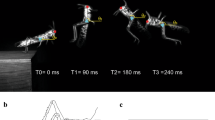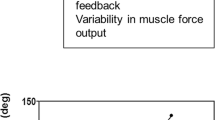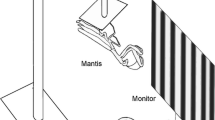Summary
This paper addresses two questions. 1. Does Schistocerca gregaria detect edges which are defined solely by velocity-contrast, that is by the difference in the image speeds generated by an object and its background when the locust moves? 2. Is the locust's ability to measure the distance of a target by motion parallax independent of the relative motion between target and back-ground?
A locust walking on a circular platform was surrounded by a stationary cylinder which was lined with an irregular texture. Against this background, the insect viewed 3 stationary, equidistant targets. One target was black, one grey and the last was textured like the cylinder. Peers and jumps were aimed preferentially at the textured and black targets showing that targets can be detected by virtue of their velocity-contrast with the background. When textured targets were wide, jumps were seen to be aimed at the targets' edge.
To assess whether velocity-contrast between target and background distorts distance-estimates, we used jump-velocity as a measure of apparent distance and examined how it varied with different arrangements of target and background. When a textured background is close to a target or the target is very wide, velocity contrast is small. The locust's jump-velocity is then 10% greater than when velocity-contrast is increased by making the background distant or the target narrow. This suggests that the locust is efficient at separating signals encoding absolute motion from those encoding relative motion.
Similar content being viewed by others
References
Cartwright BA, Collett TS (1979) How honey-bees know their distance from a nearby visual landmark. J Exp Biol 82:367–372
Collett TS (1978) Peering — a locust behaviour pattern for obtaining motion parallax information. J Exp Biol 76:237–241
Collett TS (1988) How ladybirds approach nearby stalks: a study of visual selectivity and attention. J Comp Physiol A163:355–363
Egelhaaf N, Hausen K, Reichardt W, Wehrhahn C (1988) Visual course control in flies relies on neuronal computation of object and background motion. Trends Neurosci 11:351–358
Eriksson ES (1980) Movement parallax and distance perception in the grasshopper (Phaulacridum vittatum (Sjöstedt)). J Exp Biol 86:337–341
Goulet M, Campan R, Lambin M (1981) The visual perception of relative distances in the wood cricket, Nemobius sylvestris. Physiol Entomol 6:357–367
Helmholtz H von (1866) Handbuch der Physiologischen Optik. Voss, Hamburg
Horridge GA (1986) A theory of insect vision: velocity parallax. Proc R Soc LondonB 229:13–27
Horridge GA (1987) The evolution of visual processes and the construction of seeing systems. Proc R Soc London B 230:270–292
Kirchner WH, Srinivasan MV (1989) Freely flying honeybees use image motion to estimate object distance. Naturwissenschaften 76:281–282
Lehrer M, Srinivasan MV, Zhang SW, Horridge GA (1988) Motioncues provide the bee's world with a third dimension. Nature 332:356–357
Nakayama K, Loomis JM (1974) Optical velocity patterns, velocity sensitive neurons, and space perception: a hypothesis. Perception 3:63–80
Osorio D, Srinivasan MV, Pinter RB (1990) What causes edge fixation in walking flies? J Exp Biol 149:281–292
Reichardt W, Poggio T (1979) Figure-ground discrimination by relative motion in the visual system of the fly. Part 1: Experimental results. Biol Cybern 35:81–100
Sobel EC (1990) The locust's use of motion parallax to measure distance. J Comp Physiol A167:579–588
Srinivasan MV, Lehrer M, Horridge GA (1990) Visual-figure ground discrimination in the honeybee: the role of motion parallax at boundaries. Proc R Soc London B238:331–350
Varjú D (1976) Visual edge fixation and negative phototaxis in the mealworm beetle, Tenebrio molitor. Biol Cybern 25:17–26
Wallace GK (1959) Visual scanning in the desert locust Schistocerca gregaria, Forskål. J Exp Biol 36:512–525
Zänkert A (1938/1939) Vergleichend-morphologische und physiologisch-funktionelle Untersuchungen an Augen beutefangender Insekten. Sitz Ber Ges Naturforsch Berlin 1–3:82–169
Zeil J (1989) The role of behaviour in depth information processing: orientation nights and landmark orientation in solitary wasps. In: Erber J, Menzel R, Pflüger H-J, Todt D (eds) Neural mechanisms of behaviour. Proc 2nd Int Congr Neuroethol. Georg Thieme, Stuttgart New York, pp 236–237
Author information
Authors and Affiliations
Rights and permissions
About this article
Cite this article
Collett, T.S., Paterson, C.J. Relative motion parallax and target localisation in the locust, Schistocerca gregaria . J Comp Physiol A 169, 615–621 (1991). https://doi.org/10.1007/BF00193551
Accepted:
Issue Date:
DOI: https://doi.org/10.1007/BF00193551




